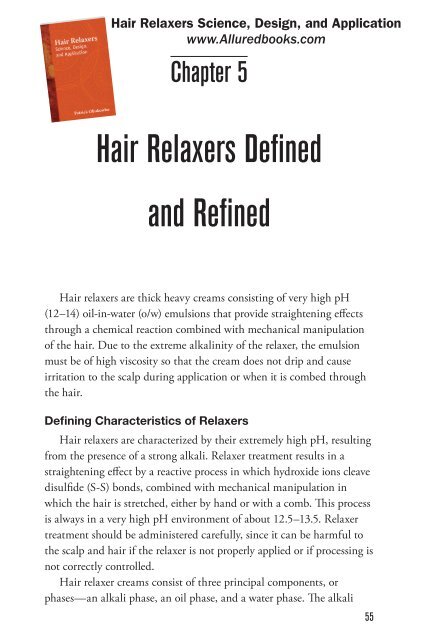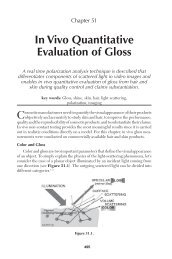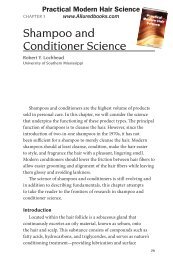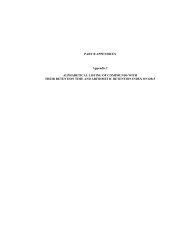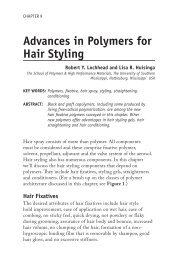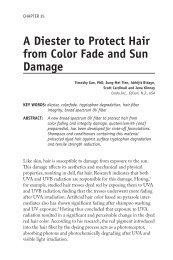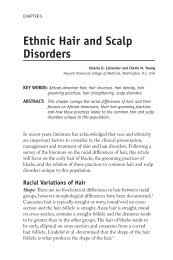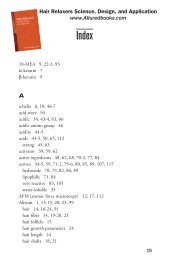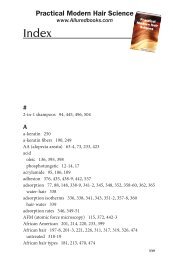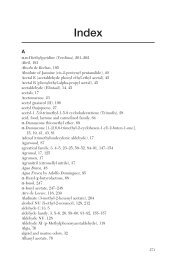Chapter 5: Hair Relaxers Defined and Refined - Allured Books
Chapter 5: Hair Relaxers Defined and Refined - Allured Books
Chapter 5: Hair Relaxers Defined and Refined - Allured Books
You also want an ePaper? Increase the reach of your titles
YUMPU automatically turns print PDFs into web optimized ePapers that Google loves.
<strong>Hair</strong> <strong>Relaxers</strong> Science, Design, <strong>and</strong> Application<br />
www.<strong>Allured</strong>books.com<br />
<strong>Chapter</strong> 5<br />
<strong>Hair</strong> <strong>Relaxers</strong> <strong>Defined</strong><br />
<strong>and</strong> <strong>Refined</strong><br />
<strong>Hair</strong> relaxers are thick heavy creams consisting of very high pH<br />
(12–14) oil-in-water (o/w) emulsions that provide straightening effects<br />
through a chemical reaction combined with mechanical manipulation<br />
of the hair. Due to the extreme alkalinity of the relaxer, the emulsion<br />
must be of high viscosity so that the cream does not drip <strong>and</strong> cause<br />
irritation to the scalp during application or when it is combed through<br />
the hair.<br />
Defining Characteristics of <strong>Relaxers</strong><br />
<strong>Hair</strong> relaxers are characterized by their extremely high pH, resulting<br />
from the presence of a strong alkali. Relaxer treatment results in a<br />
straightening effect by a reactive process in which hydroxide ions cleave<br />
disulfide (S-S) bonds, combined with mechanical manipulation in<br />
which the hair is stretched, either by h<strong>and</strong> or with a comb. This process<br />
is always in a very high pH environment of about 12.5–13.5. Relaxer<br />
treatment should be administered carefully, since it can be harmful to<br />
the scalp <strong>and</strong> hair if the relaxer is not properly applied or if processing is<br />
not correctly controlled.<br />
<strong>Hair</strong> relaxer creams consist of three principal components, or<br />
phases—an alkali phase, an oil phase, <strong>and</strong> a water phase. The alkali<br />
55
<strong>Chapter</strong> 5<br />
phase constitutes the active component of the relaxer <strong>and</strong> consists of a<br />
water-soluble/water-dispersible alkaline agent that is prepared separately<br />
<strong>and</strong> is added to the emulsion once it is formed.<br />
The water phase usually consists of a mixture of water <strong>and</strong> propylene<br />
glycol, the latter of which is a humectant added to prevent excessive<br />
water loss. The water phase is added to the oil phase with heating to<br />
form the emulsion; in the case of a relaxer, an o/w emulsion forms<br />
as the batching process proceeds, provided it is formulated properly.<br />
Relaxer preparations are just one example of the many o/w emulsions<br />
that are used in personal care products. It is important for first-time<br />
formulators to note that the type of emulsion (o/w or w/o) formed is<br />
dependent on the particular hydrophilic-lipophilic balance (HLB) of<br />
the emulsifier mix in the oil phase, not on the physical methods or<br />
sequence of combining the two phases.<br />
The addition of the active phase to the emulsion is a critical step<br />
<strong>and</strong> must be done with care, because the alkalis are very reactive,<br />
especially in the case of sodium hydroxide. Once the active phase has<br />
been prepared separately, it should be brought to the same temperature<br />
as the emulsion before it is added. When formulating a lye relaxer, it<br />
is advisable to take further precautions <strong>and</strong> lower the heat of reaction<br />
of sodium hydroxide before adding it to the emulsion. Otherwise, the<br />
highly reactive sodium hydroxide in water could react aggressively to<br />
break the emulsion, resulting in a longer batching process that slows<br />
down re-formation of the batch. In such a situation, very cold water is<br />
rapidly circulated around the manufacturing tank to bring down the<br />
temperature, so as to normalize re-formation of the emulsion.<br />
As discussed earlier, the active in hydroxide relaxers may be a strong<br />
base, such as sodium hydroxide (lye relaxer), or lithium hydroxide <strong>and</strong><br />
potassium hydroxide (no-lye, no-mix relaxers); in no-lye relaxers, the<br />
alkali used is the weaker calcium hydroxide/guanidine carbonate base<br />
<strong>and</strong> is formulated in two separate steps to yield guanidine hydroxide.<br />
It should also be noted that the methods of manufacturing a sodium<br />
hydroxide relaxer <strong>and</strong> a no-lye relaxer are somewhat different, in that<br />
the types of equipment used to ensure uniform distribution of the<br />
56
<strong>Hair</strong> <strong>Relaxers</strong> <strong>Defined</strong> <strong>and</strong> <strong>Refined</strong><br />
various actives are not the same. Although no-lye relaxers claim to<br />
have no traces of lye-like or caustic soda character, this statement is<br />
not entirely true, because the three hydroxides are in the same family<br />
of metal hydroxides as sodium hydroxide. Furthermore, various<br />
opinions over the use of lye vs. no-lye actives have been b<strong>and</strong>ied about<br />
for years but are largely the result of “market-speak” <strong>and</strong> not scientific<br />
verification.<br />
The oil phase typically contains all the primary oils, plus high<br />
HLB surfactants (emulsifiers). Petrolatum <strong>and</strong> mineral oil are used<br />
almost universally, often as a mixture with other oils <strong>and</strong> fats. The<br />
choice of surfactants is extremely important, as it is absolutely<br />
necessary to have the right emulsifier mix in the right ratio to achieve<br />
simultaneous release of the oils <strong>and</strong> active during hair processing. The<br />
types of surfactants used are typically nonionics, but in some cases,<br />
anionic surfactants are used. Nonionic surfactants are the emulsifiers<br />
of choice because they have no charges, offer a wide range of HLBs<br />
with a high degree of electrolyte tolerance, <strong>and</strong> offer some degree of<br />
conditioning that is conferred to the hair <strong>and</strong> scalp during relaxer<br />
application. Thus, the oil phase not only serves as the emulsifier for<br />
simultaneous release of the oil <strong>and</strong> active, but also acts as a conditioning<br />
component to provide the scalp with some barrier protection, add sheen<br />
to the hair, <strong>and</strong> improve its combing properties.<br />
Refining the Relaxer<br />
Once hair relaxers were commercialized, their popularity gained<br />
ground quickly with African-Americans <strong>and</strong> other women with very<br />
curly hair. However, over time, reports that hair loss <strong>and</strong> breakage were<br />
occurring with prolonged use of these products had begun to trickle in,<br />
alerting ethnic hair care companies of the problem.<br />
Unfortunately, in those days little data had been gathered on the<br />
long-term effects of straightening the hair or on the emulsion aspects<br />
of delivering strong alkali actives. Attempts to improve these earlier<br />
systems had product development chemists back at the bench scrambling<br />
to find solutions <strong>and</strong> experimenting with such variables as the<br />
57
<strong>Chapter</strong> 5<br />
percentage of water in the formulation vs. irritation level, the ability<br />
of the relaxer to penetrate hair vs. irritation level, <strong>and</strong> the active level<br />
of sodium hydroxide vs. a tolerable irritation level. 1<br />
The original hair relaxer had been developed as a caustic soapbased<br />
system using stearic acid <strong>and</strong> sodium hydroxide, but by the<br />
1950s lye relaxers were being prepared as w/o emulsions in which<br />
the sodium hydroxide was first dissolved in water <strong>and</strong> then this solution<br />
was dispersed or emulsified into an oil mixture. After making a<br />
series of adjustments to the concentration of lye <strong>and</strong> oils, formulators<br />
determined that the optimum ratio was a 50/50 mixture of the oil <strong>and</strong><br />
water phases. Formulated at this level, the relaxer lessened the incidence<br />
<strong>and</strong> severity of burning <strong>and</strong> stinging associated with the original<br />
version, but still effectively straightened the hair. Any emulsion with a<br />
higher concentration of oils reduced the straightening properties <strong>and</strong><br />
any with a higher concentration of water <strong>and</strong> active caused considerably<br />
more irritation.<br />
Despite their improvement over the earlier soap-based product,<br />
these lye relaxer emulsions still had high irritation potential <strong>and</strong><br />
often contained levels of sodium hydroxide as high as 3.5%. This<br />
required a pre-coating or “base layer” of petroleum jelly applied to the<br />
scalp <strong>and</strong> hairline to protect the skin around the forehead, ears, <strong>and</strong><br />
neckline. Thus, the term base relaxer was adopted. Due to its tendency<br />
to irritate the scalp <strong>and</strong> surrounding skin, <strong>and</strong> the extra time needed to<br />
pre-treat the area, the base relaxer fell into disuse <strong>and</strong> was eventually<br />
replaced by the no-base lye relaxer, which was generally available only<br />
to professional stylists <strong>and</strong> subsequently became the relaxer of choice<br />
for salon use.<br />
As more knowledge about emulsion control was gained, formulators<br />
began to realize that the formation of micelles <strong>and</strong> the configuration<br />
of water/oil droplets in an emulsion affected delivery of the active.<br />
When the relaxer emulsion was applied <strong>and</strong> massaged into the hair, the<br />
micelles broke, releasing the water/lye mixture <strong>and</strong> allowing the active<br />
to penetrate the cortex, yet leaving the oil portion on the cuticle where<br />
it could provide conditioning effects. This simultaneous action of the<br />
58
<strong>Hair</strong> <strong>Relaxers</strong> <strong>Defined</strong> <strong>and</strong> <strong>Refined</strong><br />
water with the actives <strong>and</strong> oils on the hair <strong>and</strong> scalp constitutes the core<br />
of good relaxer technology.<br />
As a result of this improvement, a base layer of petroleum jelly was<br />
no longer necessary, marking the advent of no-base relaxers. Unlike<br />
base relaxers, no-base relaxers contain only 1.5–2.5% actives, <strong>and</strong> at<br />
this lower concentration, the hairline alone needs pre-treating, not the<br />
scalp. These improvements in the relaxer also gave the product more<br />
stability, caused less damage to hair, <strong>and</strong> therefore, made it much more<br />
marketable.<br />
Irritation to the scalp, however, remained a problem. The development<br />
of the no-lye relaxer (calcium hydroxide/guanidine carbonate)<br />
evolved out of efforts to reduce the scalp issues that continued to<br />
persist with the use of hydroxide relaxers. These no-lye relaxers were<br />
introduced in 1978 <strong>and</strong> were geared to consumers. Sold as kits, no-lye<br />
relaxers consist of a base cream containing 4–7% calcium hydroxide,<br />
plus a separate liquid activator containing guanidine carbonate. The<br />
two parts are combined in situ just before use, at which time they react<br />
to form calcium carbonate <strong>and</strong> guanidine hydroxide, the latter of which<br />
is the active that straightens the hair. No-lye relaxers do not need basing<br />
<strong>and</strong> usually include built-in conditioners in the kit intended to help<br />
repair hair damage “on the spot” as it occurs during relaxing. Although<br />
no-lye relaxers were found to be less irritating to the scalp, they were<br />
reported to be less effective than hydroxide relaxers in relaxing tight<br />
curls. 1,2 However, this observation is more likely to be the result of<br />
inadequate mixing or improper reacting between the base cream <strong>and</strong><br />
the activator.<br />
Today, there is no absolute baseline established for the amount of<br />
actives that should be used in relaxer formulas; however, it is essential<br />
for the formulating chemist to have a good grasp of the chemical<br />
nature of each of the actives <strong>and</strong> their reactivity before determining<br />
what levels to use. Lye relaxers manufactured in the United States <strong>and</strong><br />
around the world generally have active levels ranging from 1.9–2.5%<br />
by weight of sodium hydroxide, depending on their strength. In<br />
no-lye relaxers; the levels for calcium hydroxide usually range from<br />
59


